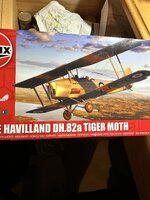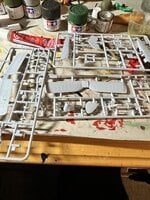OK....Dk.G added and masks off; decals safe and sound. Not 100% but as close as the likes of me can get. Had I had the instruction sheet I could have printed it out and used it for reference.
The before and after
Let it dry, gloss and resume
Actually I have a note ... the camo spot on the starboard fin and rudder. According to the most pics of the Spitfires the Dark Green spot didn't "float" in the air. It was unified with the camo spot on the stabilizer + elevator and the one on the fuselage at the tail band. The fuselage one was the continuation of the port side camo and usually was running up to the stabilizer root and its trailing edge. The only difference I found was the way the camo spot on the starboard fin and rudder was joining the patch on the stabilizer+elevator. The shape of the the patch on the stabilizer+elevator either could be the one large colour spot from the root to the trim tab actuator/trim tab or the narrower one with some of the Ocean Grey paint at the root. The color continuity may not be noticed because of the fin flash there that covered it partially and was located slightly down or was taller.
the pic source: the net.



